How To Get Rid Of Popcorn Ceiling
11 Tips on How to Remove a Popcorn Ceiling Faster and Easier
Popcorn ceilings were all the rage back in the '60s and '70s. Applying the texture to drywall and plaster ceilings was a quick and easy way to hide imperfections and didn't require any painting afterward. But the rough texture catches lots of dust and cobwebs and it can be difficult to know how to remove popcorn ceiling. It can be a real pain to match if you have cracks or holes in need of patching. Figuring out how to remove a popcorn ceiling texture from a ceiling is a messy chore but worth the effort if the substrate underneath is in good shape. Here are some tips to take some of the pain out of popcorn ceiling removal.
Every editorial product is independently selected, though we may be compensated or receive an affiliate commission if you buy something through our links. Ratings and prices are accurate and items are in stock as of time of publication.
1 / 12
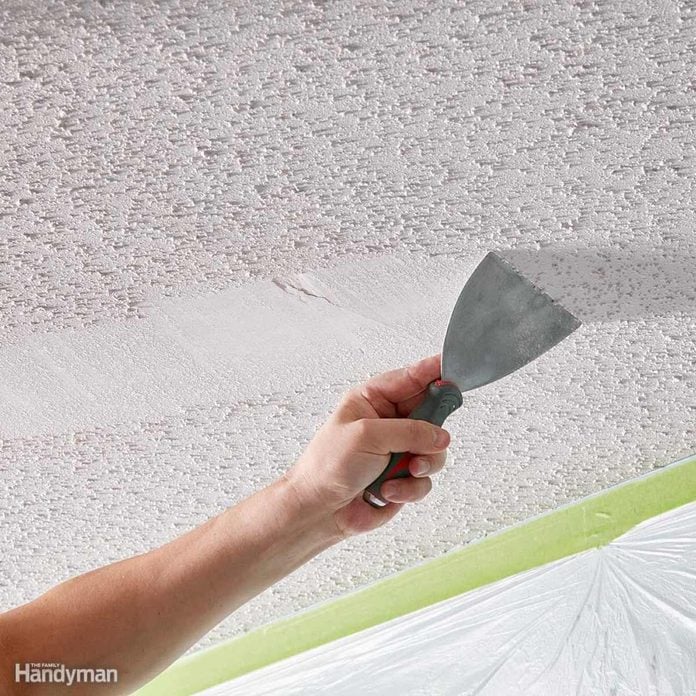 Family Handyman
Family Handyman
Do a Scrape Test
Before you go to all the trouble of prepping the room, try scraping a small area while learning how to remove popcorn ceiling. Try it dry first, then dampen the texture with water and try again. Some texture comes off easily without water, but in most cases wetting is best. If the water doesn't soak in and soften the texture, the ceiling has probably been painted or paint was added to the texture mix. In that case, wetting the ceiling may not help, and you'll have to decide whether you want to tackle a really tough scraping job or choose another way to hide your popcorn ceiling.
2 / 12
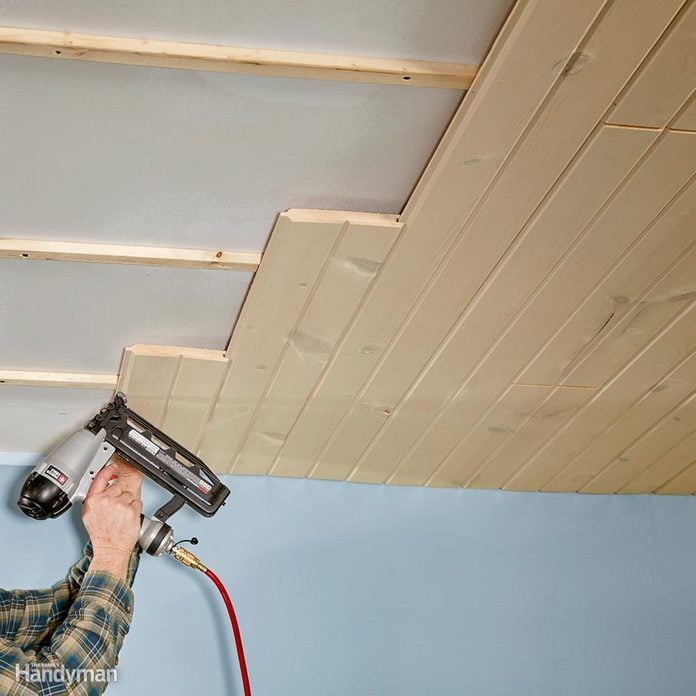 Family Handyman
Family Handyman
Test for Asbestos
Any popcorn ceiling installed before 1980 might contain asbestos—a known cause of lung cancer. Before trying to figure out how to remove any popcorn ceiling texture, contact your local health department and ask about getting a sample tested. So you're wondering how to remove a popcorn ceiling with asbestos? If the test comes back positive, cover the popcorn with new drywall or tongue-and-groove planks, or hire an asbestos abatement contractor to help in removing popcorn ceiling.
ⓘ
3 / 12
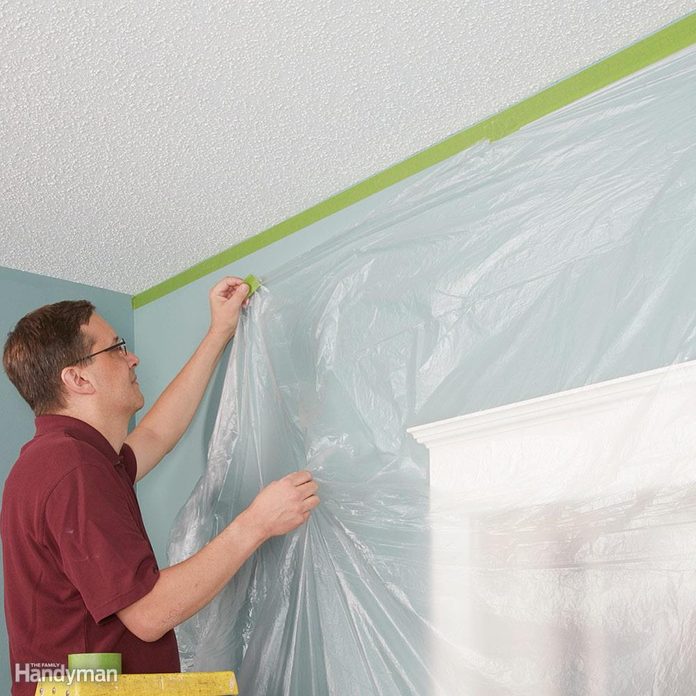 Family Handyman
Family Handyman
Prep for a Big Mess
Cover floors and walls with plastic drop cloths as you begin your how to remove popcorn ceiling project. Don't use canvas drop cloths because water can soak through. Cleanup is easier with plastic too, because you can just ball it all up when you're done working and throw it in the trash. Leave the plastic in place after popcorn ceiling removal to catch the mess you'll make repairing and sanding the ceiling later.
4 / 12
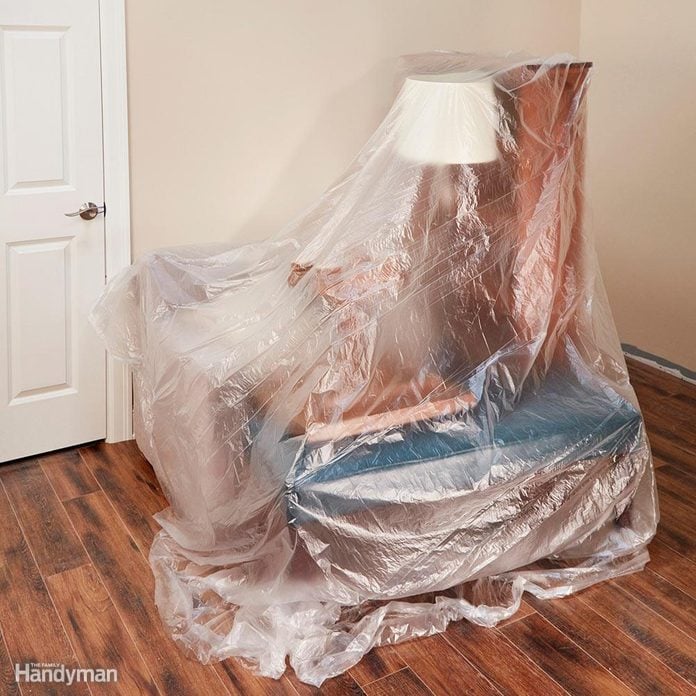 Family Handyman
Family Handyman
Get the Furniture Out
If possible, remove all furniture from the room you'll be working in. When learning how to remove popcorn ceiling, it is messy work, and you won't want furniture in your way every time you move the ladder around. If moving everything out of the room isn't possible, cluster it and cover it with drop cloths.
5 / 12
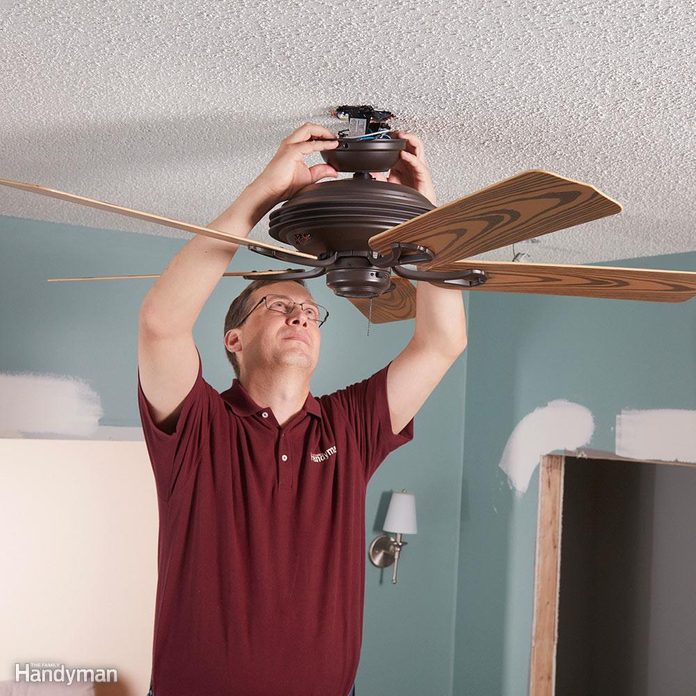 Family Handyman
Family Handyman
Remove Ceiling Fixtures and Fans
You might think it's easier to leave light fixtures and ceiling fans in place as you figure out how to remove popcorn ceiling, but they'll just be in your way and get covered with wet popcorn. Plus, you don't want to accidentally spray water into an electrical fixture.
6 / 12
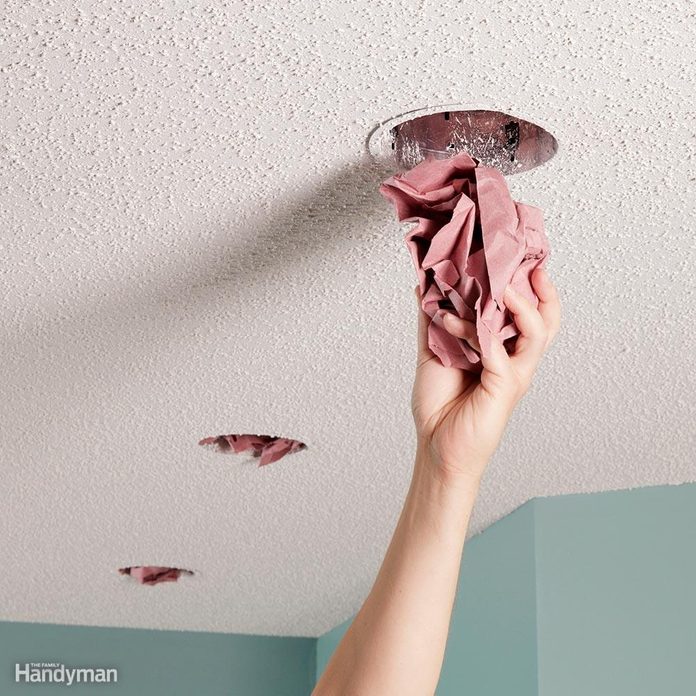 Family Handyman
Family Handyman
Protect Can Lights From Water Spray
If you have recessed "can" lights, stuff newspaper or rosin paper inside them to keep them dry when completing a how to remove popcorn ceilings project. Also, make sure the power to those fixtures is turned off at the circuit breaker panel or fuse box.
7 / 12
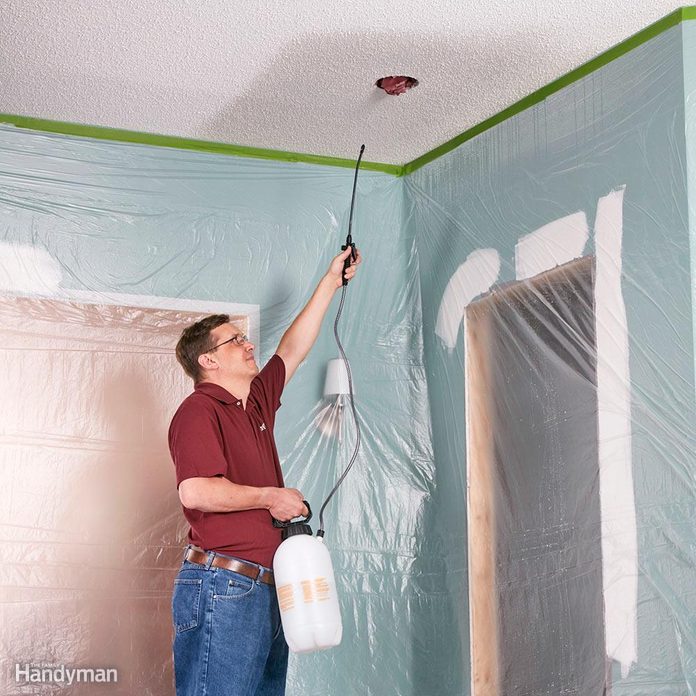 Family Handyman
Family Handyman
Wet it With a Pump Sprayer
For easier scraping and practically no dust during popcorn ceiling removal, use a garden pump sprayer to mist the ceiling and let it soak in for about 15 minutes before scraping. Only give it a light misting—too much water could damage the drywall or loosen the joint tape. If the texture hasn't softened after 15 minutes or so, spray it again and wait another 10 to 15 minutes.
If the texture still hasn't softened, it might be painted, or paint might have been mixed into the texture before application. In either case, water won't easily penetrate. If the texture is painted, you might be able to dry-scrape it first to expose some of the unpainted texture and follow up with wet scraping. If the texture has paint mixed in, you might have to dry-scrape the whole ceiling or cover it up with drywall or T&G boards.
8 / 12
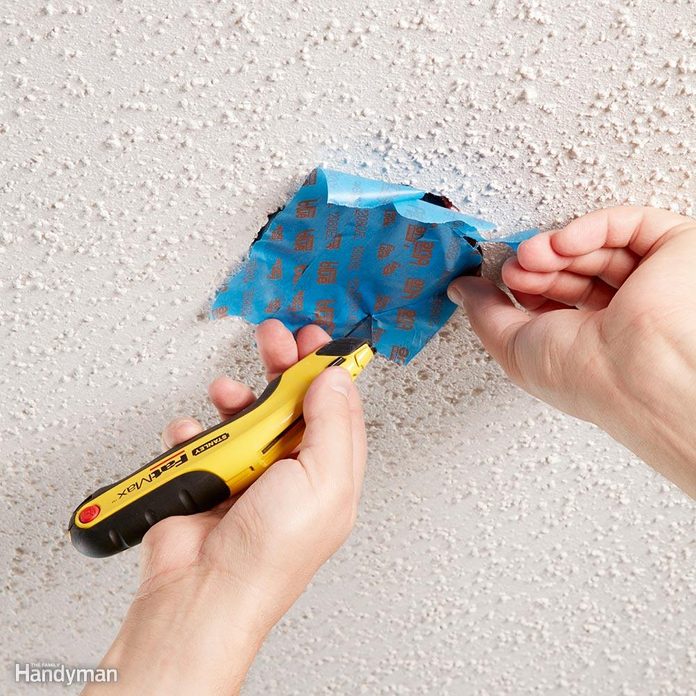 Family Handyman
Family Handyman
Cover Electrical Boxes
Shut off the power to any electrical junction boxes in the ceiling and cover them with painter's tape to keep the wiring dry when spraying water on the popcorn as you complete a how to remove popcorn ceilings project. Overlap the sides of the junction box with the tape, and then trim around the perimeter with a utility knife, being careful not to nick the wires.
9 / 12
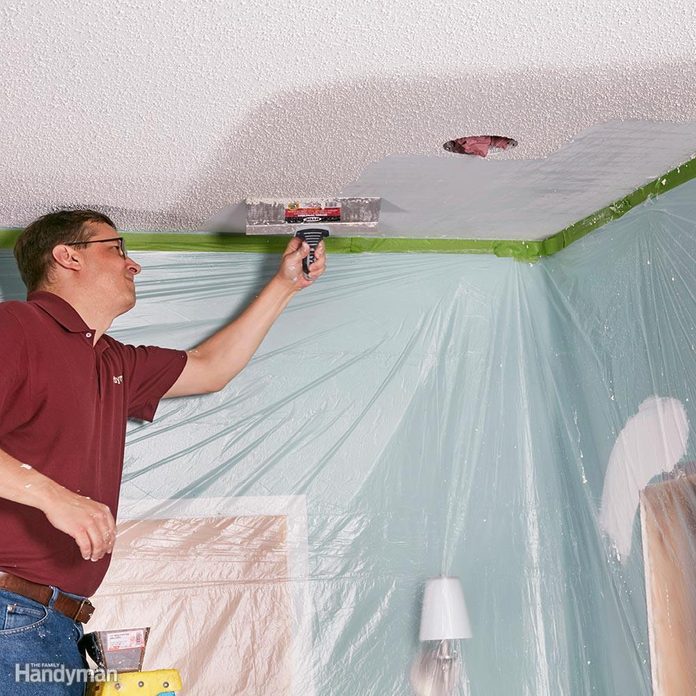 Family Handyman
Family Handyman
Work in Small Sections
Only spray and scrape a small area at a time—about 4 x 4 ft. If you work too large of an area at once, the popcorn might dry before you have time to scrape it off. If that happens, respray the area and wait another 10 to 15 minutes before scraping.
10 / 12
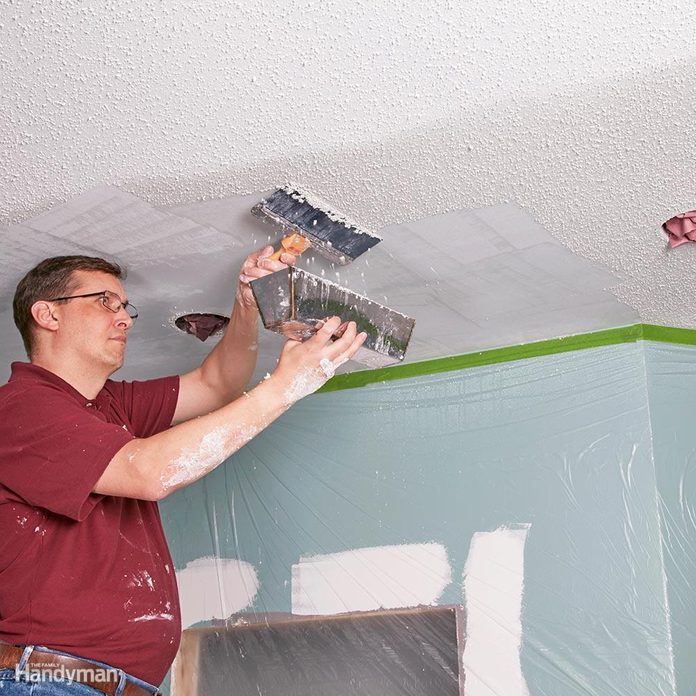 Family Handyman
Family Handyman
Tame the Mess With a Mud Pan
Use a mud pan—the kind for holding joint compound—to catch the wet popcorn before it hits the floor. That way, you're not tracking it all over the place when you walk and move the ladder around. Also, use the edge of the pan to clean off your scraper when it gets loaded up with wet popcorn.
12 / 12
 Family Handyman
Family Handyman
Smooth After Scraping
Scraping alone won't leave you with a paint-ready ceiling. You'll probably have small dings and gouges to fix. At a minimum, you'll have to sand the ceiling to get it perfectly smooth before painting.
Originally Published: October 17, 2019
Sign up for DIY projects sent right to your inbox
Complete DIY projects like a pro! Sign up for our newsletter!

Subscribe & SAVE 1 Year Subscription
for only $10!
How To Get Rid Of Popcorn Ceiling
Source: https://www.familyhandyman.com/list/how-to-remove-a-popcorn-ceiling/
Posted by: jacquesowelp1978.blogspot.com

0 Response to "How To Get Rid Of Popcorn Ceiling"
Post a Comment